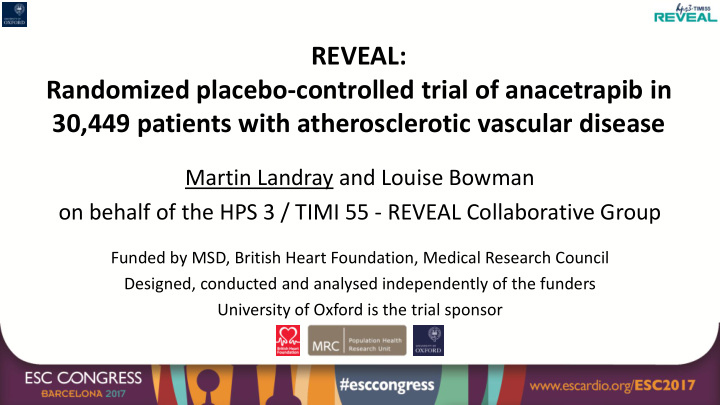



REVEAL: Randomized placebo-controlled trial of anacetrapib in 30,449 patients with atherosclerotic vascular disease Martin Landray and Louise Bowman on behalf of the HPS 3 / TIMI 55 - REVEAL Collaborative Group Funded by MSD, British Heart Foundation, Medical Research Council Designed, conducted and analysed independently of the funders University of Oxford is the trial sponsor
HPS 3 / TIMI 55 - REVEAL Collaborative Group Steering Committee Principal Investigators: Martin Landray, Louise Bowman Chair & Deputy Chair : Rory Collins, Eugene Braunwald Trial Statistician: Jemma Hopewell Regional representatives: Other members: United Kingdom : Jane Armitage, Richard Haynes Colin Baigent Philip Barter N America : Christopher Cannon, Stephen Wiviott Yiping Chen Zhengming Chen Scandinavia : Terje Pedersen Shinya Goto Alastair Gray China : Lixin Jiang Boby Mihaylova Peter Sleight Italy : Aldo Maggioni Tamio Teramoto Jonathan Tobert Germany : Georg Ertl, Christiane Angermann, Christoph Wanner Non-voting MSD representatives : Robert Blaustein, Paul DeLucca, Gerard van Leijenhorst, Yale Mitchel Data Monitoring Committee Peter Sandercock (Chair ) , David DeMets, Andrew Tonkin, John Kjekshus, James Neuberger, Jonathan Emberson ( non-voting ) With many thanks to the more than 30,000 patients and hundreds of clinicians & researchers who made this trial possible.
Background • Anacetrapib is a potent inhibitor of Cholesteryl Ester Transfer Protein (CETP) which doubles HDL-cholesterol and lowers LDL-cholesterol • Previous trials of other CETP inhibitors have been stopped after around 2 years of follow-up due to unexpected cardiovascular hazards (torcetrapib) or apparent lack of efficacy (dalcetrapib, evacetrapib) • The REVEAL trial assessed the efficacy and safety of adding anacetrapib vs. placebo to effective doses of atorvastatin among patients with established occlusive vascular disease
Effects of adding anacetrapib to intensive statin therapy • Significant 9% proportional reduction in major coronary events (effect appears to be greater in later years of treatment) • Small reduction in risk of new-onset diabetes mellitus • No excess of symptomatic side-effects with anacetrapib (levels in adipose tissue rise with continued treatment) • No excess of mortality, cancer or other serious adverse events (small increase in BP and small reduction in kidney function) • Post-trial follow-up of all consenting participants (off-drug) to assess longer-term efficacy and safety of anacetrapib Simultaneous publication in www.nejm.org
REVEAL trial design Eligibility: 30,000 patients aged over 50 years with occlusive vascular disease Background statin: Atorvastatin 20 or 80 mg daily (China: 10 or 20 mg) Mean LDL-cholesterol 61 mg/dL (1.6 mmol/L) Randomized: Anacetrapib 100 mg daily vs. matching placebo Follow-up: ≥4 years and ≥1900 primary outcomes Primary outcome: Major Coronary Event (i.e. Coronary death, myocardial infarction, or coronary revascularization) REVEAL Collaborative Group. Am Heart J 2017;187:182-90
Primary outcome: Major coronary events (Coronary death, myocardial infarction, or coronary revascularization) 15 Participants with Event (%) Anacetrapib Placebo Placebo 1640 (10.8%) 1803 (11.8%) Rate ratio 0.91 (0.85 to 0.97) 10 P=0.004 Anacetrapib 5 0 0 1 2 3 4 Years of Follow-up
Components of the primary outcome Type of Event Anacetrapib Placebo Rate Ratio (95% CI) P Value (N=15225) (N=15224) no. of participants with events (%) Coronary death 388 (2.5) 420 (2.8) 0.92 (0.80 – 1.06) 0.25 Myocardial infarction 669 (4.4) 769 (5.1) 0.87 (0.78 – 0.96) 0.007 Coronary death or MI 934 (6.1) 1048 (6.9) 0.89 (0.81 – 0.97) 0.008 Coronary revascularization 1081 (7.1) 1201 (7.9) 0.90 (0.83 – 0.97) 0.01 Major coronary event 1640 (10.8) 1803 (11.8) 0.91 (0.85 – 0.97) 0.004 0.8 1.0 1.2 Anacetrapib Better Placebo Better Major coronary event: Coronary death, MI or coronary revascularization No significant evidence of differential proportional effects among 23 pre-specified subgroup categories
Proportional reduction in Coronary death or MI vs. absolute reduction in non-HDL cholesterol (derived from published CTT meta-analysis) Proportional risk reduction 35% Statin vs. control 30% >50 mg/dL red n (4 trials) 25% REVEAL Statin vs. control 20% <50 mg/dL red n 15% (17 trials) More vs. less 10% 22 mg/dL red n 5% (5 trials) 0% 0 10 20 30 40 50 60 70 Absolute reduction in non-HDL cholesterol (mg/dL)
Other clinical assessments Assessment Anacetrapib Placebo Difference P New - onset diabetes mellitus 510 (5.3%) 571 (6.0%) - 0.6% 0.05 Blood pressure Systolic (mmHg) 132.4 131.7 +0.7 0.002 Diastolic (mmHg) 77.6 77.4 +0.3 0.04 Hypertensive serious adverse events 151 (1.0%) 141 (0.9%) +0.1% 0.56 K idney disease 2 1344 (11.5%) 1236 (10.6%) New - onset eGFR <60 mL/min/1.73m +0.84% 0.04 Renal failure s erious adverse events 169 (1.1%) 146 (1.0%) +0.15% 0.20 No effect on vascular, non - vascular, or all - cause mortality No effect on cancer, liver, muscle, cognitive function, or other adverse events
Effects of adding anacetrapib to intensive statin therapy • Significant 9% proportional reduction in major coronary events (effect appears to be greater in later years of treatment) • Small reduction in risk of new-onset diabetes mellitus • No excess of symptomatic side-effects with anacetrapib (levels in adipose tissue rise with continued treatment) • No excess of mortality, cancer or other serious adverse events (small increase in BP and small reduction in kidney function) • Post-trial follow-up of all consenting participants (off-drug) to assess longer-term efficacy and safety of anacetrapib Simultaneous publication in www.nejm.org
Recommend
More recommend